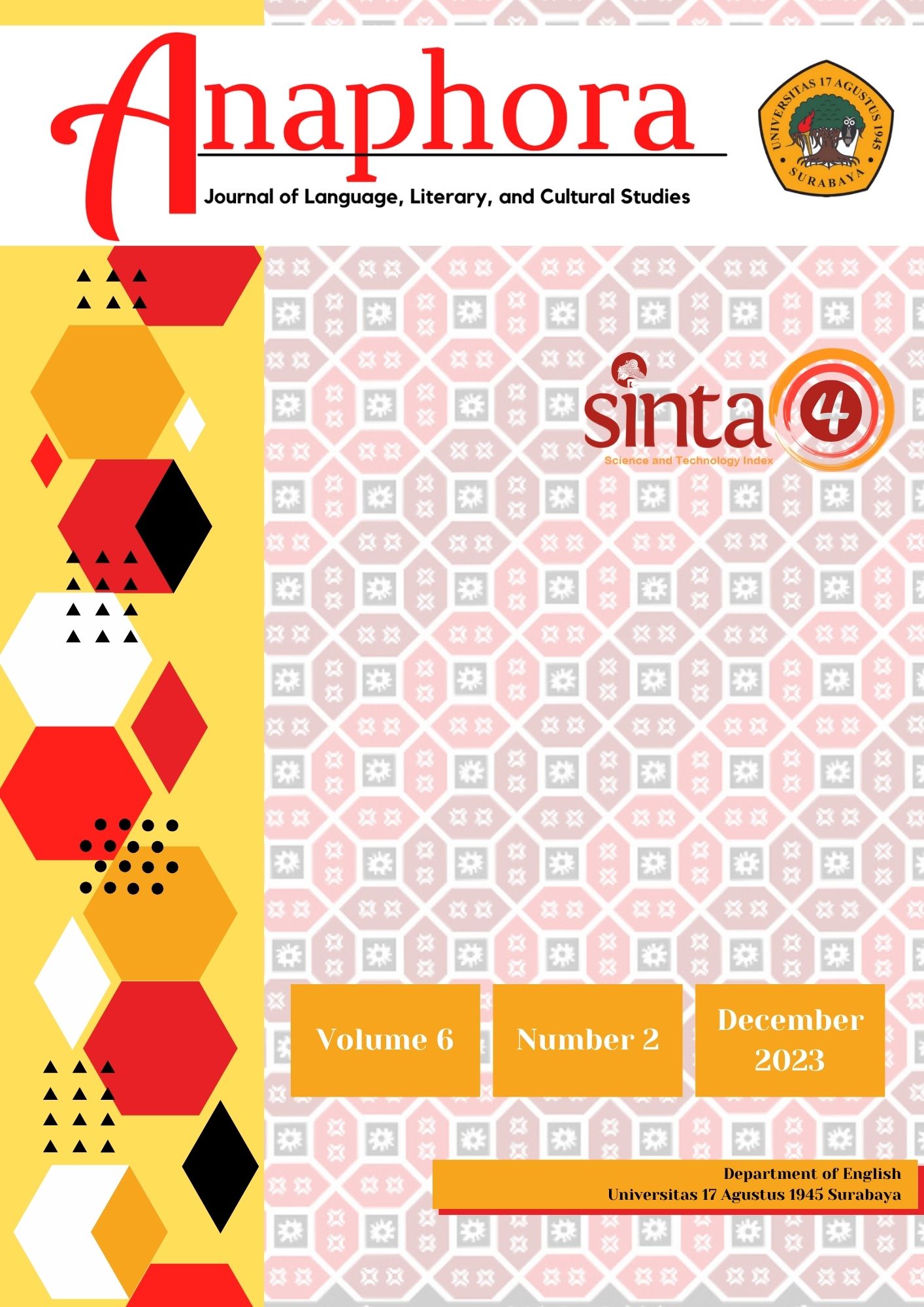The Decline of Negative Stereotype on Chinese Brand Smartphone
A Case Study on Facebook Groups
DOI:
https://doi.org/10.30996/anaphora.v6i2.7825Keywords:
circuit of culture, Chinese smartphones, Chinese brand’s imageAbstract
People’s preferences for particular brands of smartphones are inextricably linked to the variety of smartphones available in the market. As the emerging power of the world economy, China also has many smartphone brands which are highly distributed in the global market, including in Indonesia despite the negative stigma which attached to the brands. The study examines this phenomena from the scope of cultural studies using the theoretical basis of the circuit of culture (du Gay et al., 1997). The study aims to enrich the perspective on how the consumption of Chinese smartphone brands among Indonesian are regulated, produced, consumed, and represented, which further constructs the perception of how the brands’ images are perceived by the Indonesian customers. The study is conducted based on qualitative approach by observing the interaction enacted in two Facebook groups about smartphones. The analysis of the circuit of culture reveals the development of the Chinese products’ image in Indonesia. The study found that the negative image on the Chinese brands smartphones is declining among the customers. Despite the existing negative comments, the group members often recommend the Chinese brand smartphones when it comes to the functional need with affordable price. Thus, the negative perspective on Chinese brand smartphones which believed that the phones are low quality low price is promisingly shifted into worth price to performance The findings shows that Chinese smartphone brands are gaining more acceptance and positive perception among Indonesian consumers based on their affordable prices and improved quality.
Downloads
References
Andrenata, A., Supeni, R. E., & Rahayu, J. (2022). PENGARUH PERCEIVED VALUE, BRAND AWARENESS, PERCEIVED QUALITY TERHADAP KEPUTUSAN PEMBELIAN SMARTPHONE XIAOMI PADA MAHASISWA UNIVERSITAS MUHAMMADIYAH JEMBER. PUBLIK: Jurnal Manajemen Sumber Daya Manusia, Adminsitrasi Dan Pelayanan Publik, IX(4), 813–824.
Asshifa, R. D., & Yuniarinto, A. (2021). PENGARUH COUNTRY OF ORIGIN DAN BRAND IMAGE TERHADAP KEPUTUSAN PEMBELIAN SMARTPHONE PENGARUH COUNTRY OF ORIGIN DAN BRAND IMAGE TERHADAP KEPUTUSAN PEMBELIAN SMARTPHONE SAMSUNG DENGAN WORD OF MOUTH SEBAGAI VARIABEL MODERASI (STUDI PADA PENGGUNA SMARTPHONE SA. Jurnal Ilmiah Mahasiswa FEB, 10(2).
Beneke, J., Mill, J., Naidoo, K., & Wickham, B. (2015). The impact of willingness to engage in negative electronic word-of- mouth on brand attitude: a study of airline passengers in South Africa. Journal of Business and Retail Management Research (JBRMR), 9(2), 68–84.
du Gay, P., Hall, S., Janes, L., Mackay, H., & Negus, K. (1997). DOING CULTURAL STUDIES: The Story of the Sony Walkman. SAGE Publications.
Fan, Y. (2006). The globalisation of Chinese brands. Marketing Intelligence and Planning, 24(4), 365–379. https://doi.org/10.1108/02634500610672107
Fatih, M. F. Al, Suharyono, & Mawardi, M. K. (2016). ANALISIS CITRA MEREK BERDASARKAN COUNTRY OF ORIGIN (Studi Tentang Citra Merek Smartphone Asal Amerika Serikat Dan Asal China Pada Mahasiswa Universitas Brawijaya). Jurnal Administrasi Bisnis (JAB), 39(1), 42–50.
Hall, S. (1990). Cultural Identity and Diaspora. Lawrence & Wishart.
Hall, S., Hobson, D., Lowe, A., & Wilis, P. (1980). Encoding/Decoding. In Culture, media, language: Working papers in cultural studies (pp. 128–138). Hutchinson.
Maulida, L. (2022, March 23). IDC: 5 Besar Vendor Smartphone di Indonesia 2021, Oppo Teratas. KOMPAS.Com. https://tekno.kompas.com/read/2022/03/23/07050067/idc--5-besar-vendor-smartphone-di-indonesia-2021-oppo-teratas
Nugroho, M. A., & Hidayati, L. L. A. (2020). Pengaruh Brand Association, Brand Awareness, Brand Image, Brand Trust dan Consumer Satisfaction Terhadap Brand Loyalty Produk Smartphone Merek Xiaomi Di Magelang. Business and Economics Conference in Utilization of Modern Technology, 566–584.
Nurunnisha, G. A., Roespinoedji, R., & Roespinoedji, D. (2021). Female Students Perceptions on The Effect of Country of Origin, Brand Ambassador on Purchase Intentions: A Study on The Geographical Origin of Tokopedia E-Commerce Company, Indonesia. Review of International Geographical Education (RIGEO), 11(1), 573–582. https://doi.org/10.48047/rigeo.11.1.41
Pharr, J. M. (2005). Synthesizing Country-of-Origin Research from the Last Decade: Is the Concept Still Salient in an Era of Global Brands? Journal of Marketing Theory and Practice, 13(4), 34–45.
Purwanto, E., & Wibisono, A. (2019). Pengaruh Country of Origin, Word of Mouth, Kualitas Yang Dipersepsikan Terhadap Niat Beli. Jurnal Riset Manajemen Dan Bisnis (JRMB) Fakultas Ekonomi UNIAT, 4(3), 365–374. https://doi.org/10.36226/jrmb.v4i3.278
Sari, D. P., & Suyanto, A. (2022). Analisis Brand Positioning Produk Smartphone Buatan China Berdasarkan Dimensi Kualitas Produk. E-Proceeding of Management, 9(3), 1300–1307.
Sun, Y., Gonzalez-Jimenez, H., & Wang, S. (2021). Examining the relationships between e-WOM, consumer ethnocentrism and brand equity. Journal of Business Research, 130(June 2021), 564–573. https://doi.org/10.1016/j.jbusres.2019.09.040
Thompson, K. W. (1997). Media and cultural regulation. SAGE PUBLICATIONS LTD.
Ulgado, F. M., Wen, N. (Amy), & Lee, M. (2011). Country Image and Brand Equity Effects of Chinese Firms and Their Products on Developed-Market Consumer Perceptions. Asian Journal of Business Research, 1(2), 1–24. https://doi.org/10.14707/ajbr.110008
Weisfeld-spolter, S., Sussan, F., & Gould, S. (2014). An integrative approach to eWOM and marketing communications. Corporate Communications: An International Journal, 19(3), 260–274. https://doi.org/10.1108/CCIJ-03-2013-0015
Wilson, N. (2020). ANALISIS PENGARUH DIMENSI CELEBRITY ENDORSER TERHADAP KESADARAN MEREK DAN INTENSI PEMBELIAN: STUDI KASUS PADA SEKTOR CHINESE-BRAND SMARTPHONE DI INDONESIA. DeReMa (Development of Research Management): Jurnal Manajemen, 15(1), 15–43. https://doi.org/10.19166/derema.v15i1.2248
Yuniar, A. M., & Aji, G. G. (2022). Pemaknaan Brand China (Studi Fenomenologi Pada Millennial Pengguna Mobil Wuling di Surabaya). Commercium, 5(1), 68–82.
Yunus, N. S. N. M., & Rashid, W. E. W. (2016). The Influence of Country-of-origin on Consumer Purchase Intention: The Mobile Phones Brand from China. Procedia Economics and Finance, 37, 343–349. https://doi.org/10.1016/s2212-5671(16)30135-6
Downloads
Published
How to Cite
Issue
Section
License
Authors whose manuscript is published will approve the following provisions:
-
The right to publication of all journal material published on the jurnal anaphora website is held by the editorial board with the author's knowledge (moral rights remain the property of the author).
-
The formal legal provisions for access to digital articles of this electronic journal are subject to the terms of the Creative Commons Attribution-ShareAlike (CC BY-SA) license, which means Jurnal Persona reserves the right to store, modify the format, administer in database, maintain and publish articles without requesting permission from the Author as long as it keeps the Author's name as the owner of Copyright.
-
Printed and electronic published manuscripts are open access for educational, research and library purposes. In addition to these objectives, the editorial board shall not be liable for violations of copyright law.















